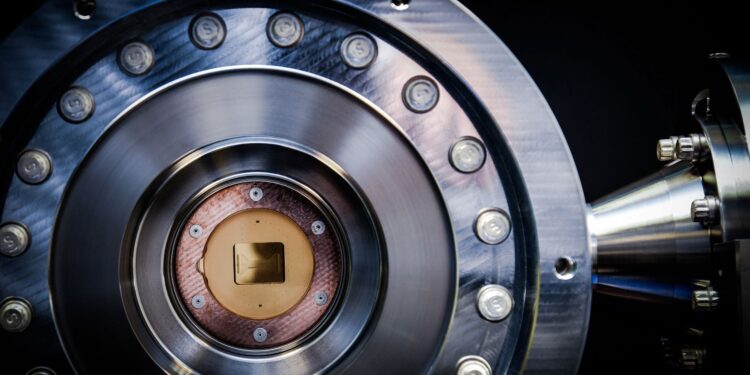by Anne J. Manning, Harvard Gazette
Inside the Quantinuum H2 quantum processor chamber. Credit: Quantinum
Our 3D physical world consists of just two types of particles: bosons, which include light and the famous Higgs boson; and fermions – the protons, neutrons and electrons that make up all the “stuff”, including today’s society.
However, theoretical physicists like Ashvin Vishwanath, the George Vasmer Leverett Professor of Physics at Harvard, don’t like to limit themselves to our world. In a 2D environment, for example, all sorts of new particles and states of matter would become possible.
Vishwanath’s team used a powerful machine called a quantum processor to create, for the first time, an entirely new phase of matter called non-Abelian topological order. Previously recognized only in theory, the team demonstrated the synthesis and control of exotic particles called non-abelian anyons, which are neither bosons nor fermions, but something in between.
Their results are published in Nature in collaboration with researchers from quantum computing company Quantinuum. Vishwanath’s team included Nat Tantivasadakarn ’22, a former student at the Harvard Kenneth C. Griffin Graduate School of Arts and Sciences, now at Caltech, and Ruben Verresen, a postdoctoral fellow.
Non-abelian anyons, known to physicists as quasiparticles, are only mathematically possible in a 2D plane. The term “quasi” refers to the fact that they are not exactly particles, but rather long-lived excitations passing through a specific phase of matter – think ocean waves – and that they have special abilities memory transport.
Besides the fact that the creation of a new phase of matter is exciting for fundamental physics, non-abelian anyons have been widely recognized as a potential platform for quantum computing, making the research results even more importance.
Non-abelian anyons are inherently stable, unlike the fragile and error-prone quantum bits, or qubits, on other quantum computing platforms. They can “remember” their past by moving around each other, like a magician shuffling cups with hidden balls. This property is also what makes them topological, that is, they can be bent and twisted without losing their fundamental identity.
For all these reasons, non-Abelian anyons could one day make ideal qubits – units of computing power that extend far beyond today’s classical computers – if they can be created and controlled at greater speed. large scale.
“A very promising path toward stable quantum computing is to use these kinds of exotic states of matter as efficient quantum bits and perform quantum calculations with them,” Tantivasadakarn said. “Then you’ve mitigated the noise issues to a large extent.”
The researchers demonstrated relentless creativity to achieve their exotic state of matter. Maximizing the capabilities of Quantinuum’s newest H2 processor, the team started with an array of 27 trapped ions. They used partial, targeted measurements to sequentially increase the complexity of their quantum system, resulting in a quantum wave function designed with the exact properties and characteristics of the particles they were looking for.
“Measurement is the most mysterious aspect of quantum mechanics, leading to famous paradoxes like Schrödinger’s cat and many philosophical debates,” Vishwanath said. “Here, we used the measurements as a tool to sculpt the quantum state of interest.”
As a theorist, Vishwanath cherishes the ability to move between ideas and applications of physics without being tied to a single platform or technology. But in the context of this work, he marvels at being able to not only explore a theory, but also demonstrate it, particularly as the field of quantum mechanics enters its 100th anniversary.
“At least for me, it was just amazing that this all worked and that we could do something very concrete,” Vishwanath said. “It really connects many aspects of physics over the years, from fundamental quantum mechanics to more recent ideas about these new types of particles.”
More information:
Mohsin Iqbal et al, Non-abelian topological order and anyons on a trapped ion processor, Nature (2024). DOI: 10.1038/s41586-023-06934-4
Provided by Harvard Gazette
This story is courtesy of the Harvard Gazette, the official newspaper of Harvard University. For more information about the university, visit Harvard.edu.
Quote: A new phase of matter: physicists achieve the first demonstration of non-abelian anyons in a quantum processor (February 21, 2024) retrieved February 21, 2024 from
This document is subject to copyright. Apart from fair use for private study or research purposes, no part may be reproduced without written permission. The content is provided for information only.



